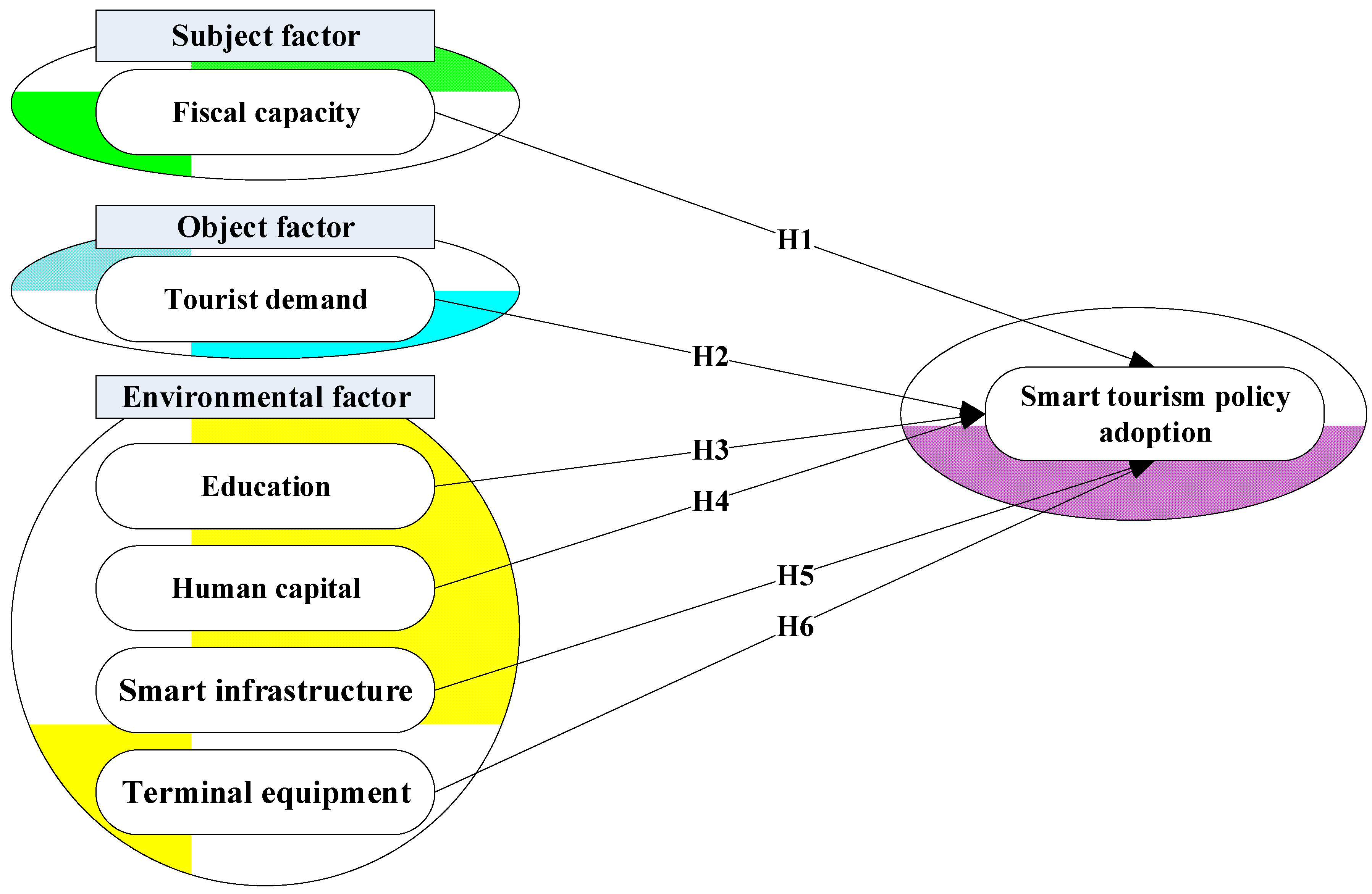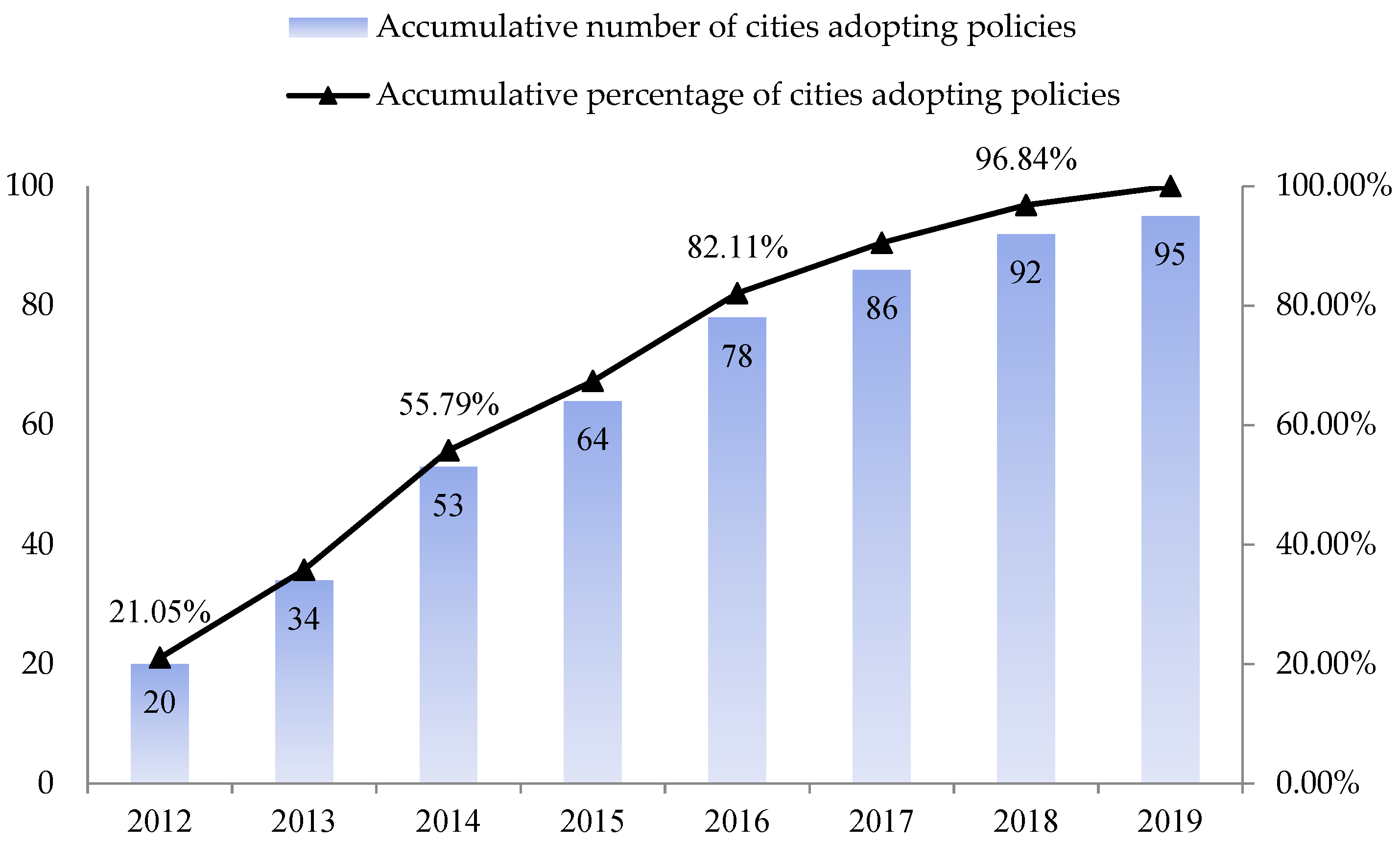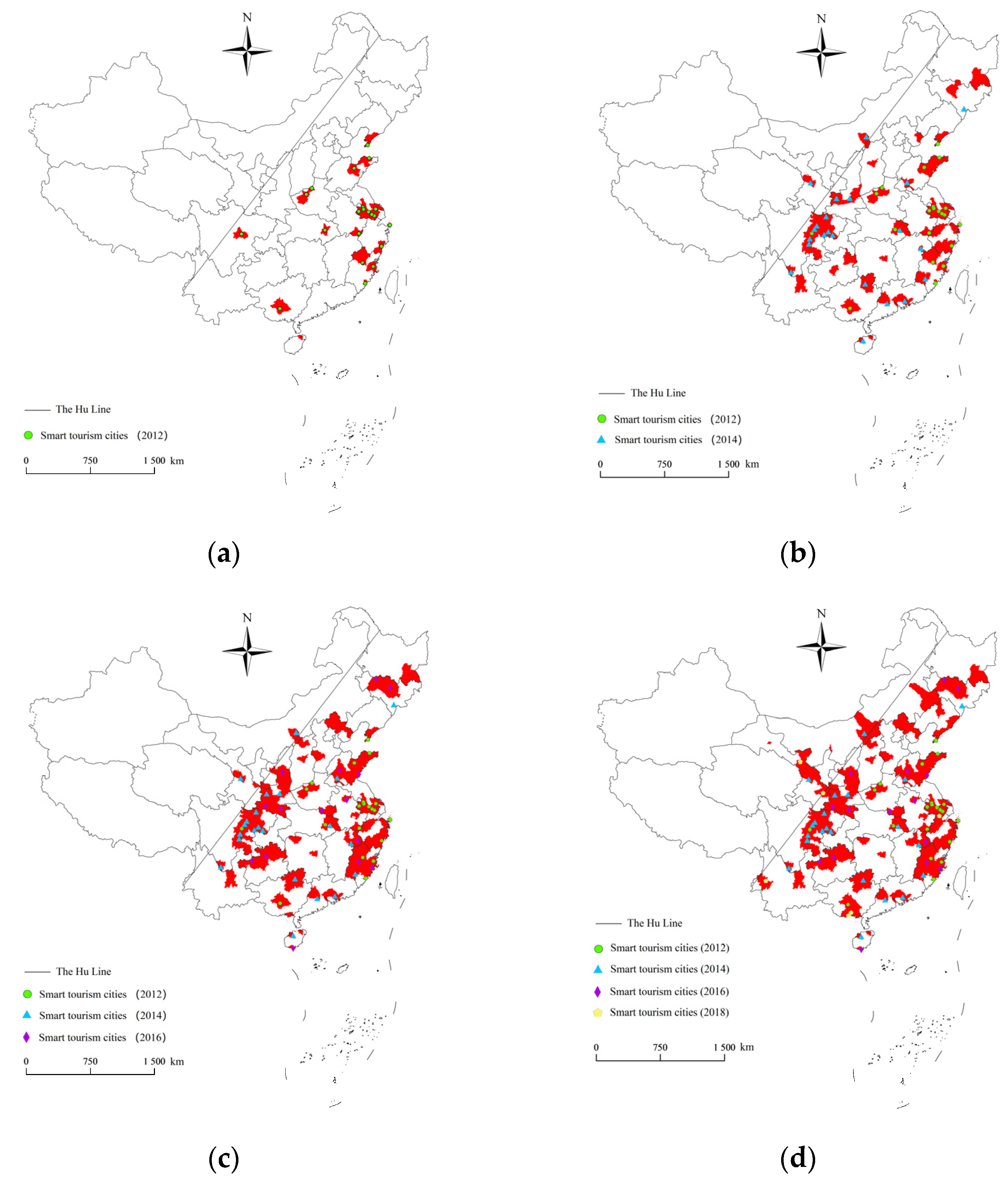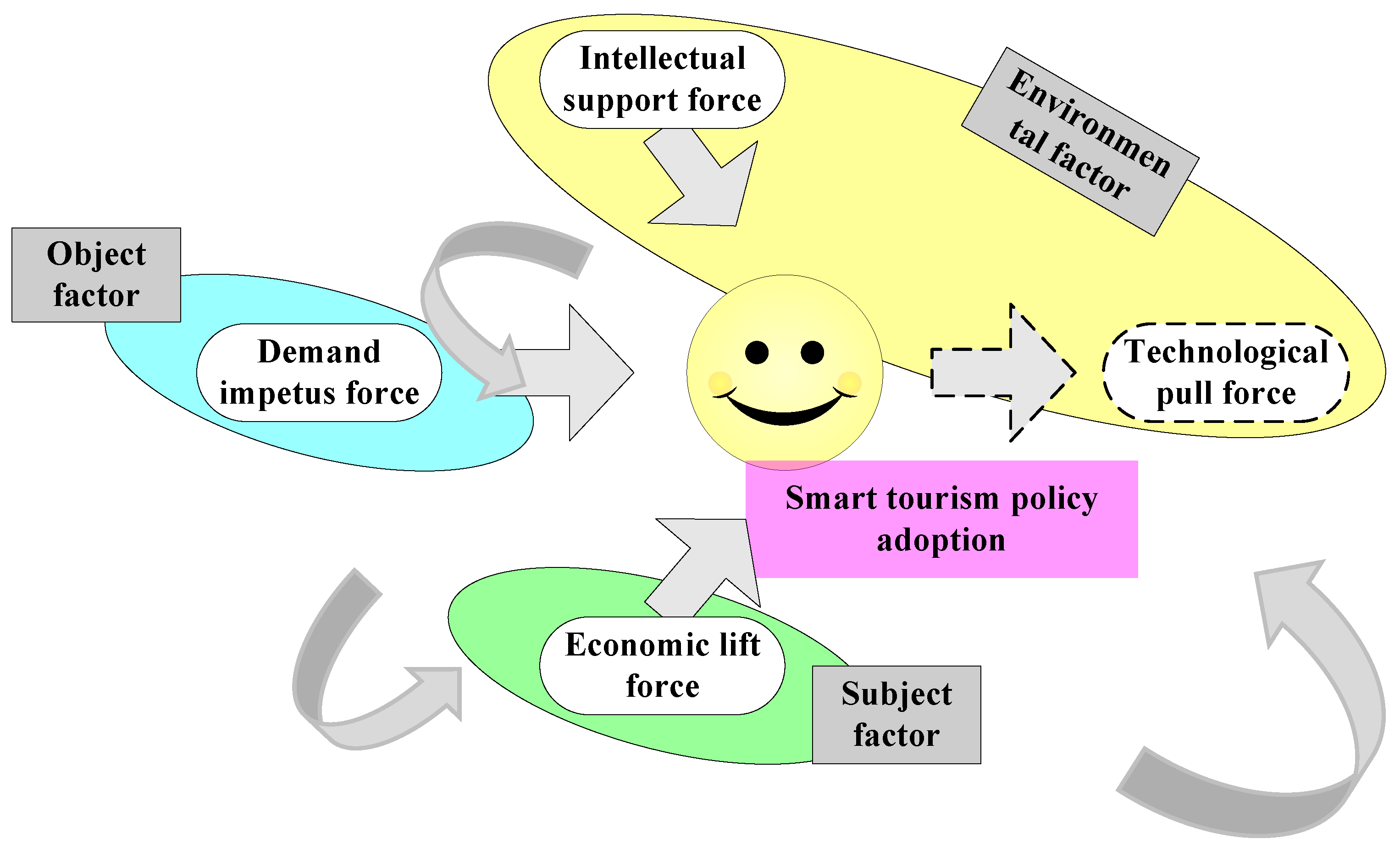Diffusion Characteristics and Driving Factors of the Smart Tourism City Policy—Event History Analysis
Abstract
:1. Introduction
2. Theory and Hypotheses Proposed
2.1. Policy Diffusion Theory
2.2. Research Hypotheses
2.2.1. Subject Factor
2.2.2. Object Factor
2.2.3. Environmental Factor
3. Data Collection and Methodology
3.1. Dependent Variable
3.2. Independent Variable
3.3. Event History Analysis
4. Results
4.1. Temporal Characteristics of Policy Diffusion
4.2. Spatial Characteristics of Policy Diffusion
4.3. Descriptive Statistics and Correlational Analysis
4.4. Driving Factors of Policy Diffusion
5. Conclusions and Implications
5.1. Conclusions and Discussion
5.2. Research Implication
Author Contributions
Funding
Institutional Review Board Statement
Informed Consent Statement
Data Availability Statement
Conflicts of Interest
References
- Ashworth, G.; Page, S.J. Urban tourism research: Recent progress and current paradoxes. Tour. Manag. 2011, 32, 1–15. [Google Scholar] [CrossRef]
- Pearce, D.G. An integrative framework for urban tourism research. Ann. Tour. Res. 2001, 28, 926–946. [Google Scholar] [CrossRef]
- Zheng, W.; Jia, H.; Lin, C.; Wang, W.; Yu, B. Using a heuristic approach to design personalized urban tourism itineraries with hotel selection. Tour. Manag. 2020, 76, 103956. [Google Scholar] [CrossRef]
- Wang, J.; Huang, X.; Gong, Z.; Cao, K. Dynamic assessment of tourism carrying capacity and its impacts on tourism economic growth in urban tourism destinations in China. J. Destin. Mark. Manag. 2020, 15, 100383. [Google Scholar] [CrossRef]
- Graymore, M.L.M.; Sipe, N.G.; Rickson, R.E. Sustaining Human Carrying Capacity: A tool for regional sustainability assessment. Ecol. Econ. 2010, 69, 459–468. [Google Scholar] [CrossRef]
- Saveriades, A. Establishing the social tourism carrying capacity for the tourist resorts of the east coast of the Republic of Cyprus. Tour. Manag. 2000, 21, 147–156. [Google Scholar] [CrossRef]
- Yang, Z.; Yang, H.; Wang, H. Evaluating urban sustainability under different development pathways: A case study of the Beijing-Tianjin-Hebei region. Sustain. Cities Soc. 2020, 61, 102226. [Google Scholar] [CrossRef]
- Antwi-Afari, P.; Owusu-Manu, D.-G.; Ng, S.T.; Asumadu, G. Modeling the smartness or smart development levels of developing countries’ cities. J. Urban Manag. 2021, 10, 369–381. [Google Scholar] [CrossRef]
- Jucevičius, R.; Patašienė, I.; Patašius, M. Digital Dimension of Smart City: Critical Analysis. Procedia—Soc. Behav. Sci. 2014, 156, 146–150. [Google Scholar] [CrossRef] [Green Version]
- Gretzel, U.; Sigala, M.; Xiang, Z.; Koo, C. Smart tourism: Foundations and developments. Electron. Mark. 2015, 25, 179–188. [Google Scholar] [CrossRef] [Green Version]
- Shafiee, S.; Ghatari, A.R.; Hasanzadeh, A.; Jahanyan, S. Developing a model for sustainable smart tourism destinations: A systematic review. Tour. Manag. Perspect. 2019, 31, 287–300. [Google Scholar] [CrossRef]
- Mohanty, P.; Hassan, A.; Ekis, E. Augmented reality for relaunching tourism post-COVID-19: Socially distant, virtually connected. Worldw. Hosp. Tour. Themes 2020, 6, 753–760. [Google Scholar] [CrossRef]
- UNWTO. UNWTO Launches Global Guidelines to Restart Tourism; UNWTO: Madrid, Spain, 2020. [Google Scholar]
- Um, T.; Chung, N. Does smart tourism technology matter? Lessons from three smart tourism cities in South Korea. Asia Pac. J. Tour. Res. 2021, 26, 396–414. [Google Scholar] [CrossRef]
- Li, Y.; Hu, C.; Huang, C.; Duan, L. The concept of smart tourism in the context of tourism information services. Tour. Manag. 2017, 58, 293–300. [Google Scholar] [CrossRef]
- Bastidas, A.; Sánchez-Fernández, J.; Casado-Aranda, L.-A. The Past, Present, and Future of Smart Tourism Destinations: A Bibliometric Analysis. J. Hosp. Tour. Res. 2020, 45, 529–552. [Google Scholar] [CrossRef]
- Caragliu, A.; Bo, C.D.; Nijkamp, P. Smart cities in Europe. J. Urban Technol. 2009, 18, 65–82. [Google Scholar] [CrossRef]
- Lazaroiu, G.C.; Roscia, M. Definition methodology for the smart cities model. Energy 2012, 47, 326–332. [Google Scholar] [CrossRef]
- Paul, V.; Rupesh, K. Responsible tourism: A strategy for grass root level empowerment. Innov. Issues Approaches Soc. Sci. (IIAAS) 2013, 7, 54–71. [Google Scholar]
- Mihalic, T. Sustainable-responsible tourism discourse—Towards ‘responsustable’ tourism. J. Clean. Prod. 2016, 111, 461–470. [Google Scholar] [CrossRef] [Green Version]
- Frey, N.; George, R. Responsible tourism management: The missing link between business owners’ attitudes and behaviour in the Cape Town tourism industry. Tour. Manag. 2010, 31, 621–628. [Google Scholar] [CrossRef]
- Wang, X.; Li, X.R.; Zhen, F.; Zhang, J. How smart is your tourist attraction? Measuring tourist preferences of smart tourism attractions via a FCEM-AHP and IPA approach. Tour. Manag. 2016, 54, 309–320. [Google Scholar] [CrossRef]
- Morrison, A.; Coca-Stefaniak, J.A. Sustainable tourism in urban destinations. Int. J. Tour. Cities 2021, 7, 881–886. [Google Scholar]
- Owaied, H.H.; Farhan, H.A.; Al-Hawamdeh, N.; Al-Okialy, N. A Model for Intelligent Tourism Guide System. J. Appl. Sci. 2011, 11, 342–347. [Google Scholar] [CrossRef] [Green Version]
- Cacho, A.; Mendes-Filho, L.; Alves, D.E.; Moura, B. Mobile tourist guide supporting a smart city initiative: A Brazilian case study. Int. J. Tour. Cities 2016, 2, 164–183. [Google Scholar] [CrossRef]
- Ruíz, M.A.C.; Bohorquez, S.T.; Molano, J.I.R. Colombian Tourism: Proposal App to Foster Smart Tourism in the Country. J. Comput. Theor. Nanosci. 2017, 23, 10533–10537. [Google Scholar] [CrossRef]
- Leung, R. Smart hospitality: Taiwan hotel stakeholder perspectives. Tour. Rev. 2018, 74, 50–62. [Google Scholar] [CrossRef]
- Siguaw, J.; Enz, C.; Namasivayam, K. Adoption of information technology in U.S. Hotels: Strategically driven objectives. J. Travel Res. 2000, 39, 192–201. [Google Scholar] [CrossRef]
- Šerić, M.; Gil-Saura, I. ICT, IMC, and Brand Equity in High-Quality Hotels of Dalmatia: An Analysis From Guest Perceptions. J. Hosp. Mark. Manag. 2012, 21, 821–851. [Google Scholar] [CrossRef]
- Goossen, M.; Meeuwsen, H.; Franke, J.; Kuyper, M. My ideal tourism destination: Personalized destination recommendation system combining individual preferences and GIS data. Inf. Technol. Tour. 2009, 11, 17–30. [Google Scholar] [CrossRef]
- Jung, T.; Chung, N.; Leue, C. The determinants of recommendations to use augmented reality technologies: The case of a Korean theme park. Tour. Manag. 2015, 49, 75–86. [Google Scholar] [CrossRef]
- Mehraliyev, F.; Chan, R.C.C.; Choi, Y.; Koseoglu, M.A.; Law, R. A state-of-the-art review of smart tourism research. J. Travel Tour. Mark. 2020, 37, 78–91. [Google Scholar] [CrossRef]
- Jeong, M.; Shin, H.H. Tourists’ Experiences with Smart Tourism Technology at Smart Destinations and Their Behavior Intentions. J. Travel Res. 2019, 59, 1464–1477. [Google Scholar] [CrossRef]
- Lee, H.; Lee, J.; Chung, N.; Koo, C. Tourists’ happiness: Are there smart tourism technology effects? Asia Pac. J. Tour. Res. 2018, 23, 486–501. [Google Scholar] [CrossRef]
- Azis, N.; Amin, M.; Chan, S.; Aprilia, C. How smart tourism technologies affect tourist destination loyalty. J. Hosp. Tour. Technol. 2020, 11, 603–625. [Google Scholar] [CrossRef]
- Gretzel, U.; Scarpino-Johns, M. Destination resilience and smart tourism destinations. Tour. Rev. Int. 2018, 22, 263–276. [Google Scholar] [CrossRef]
- Dey, B.; Sarma, M.K. Information source usage among motive-based segments of travelers to newly emerging tourist destinations. Tour. Manag. 2010, 31, 341–344. [Google Scholar] [CrossRef]
- Gretzel, U.; Zhong, L.; Koo, C. Application of smart tourism to cities. Int. J. Tour. Cities 2016, 2. [Google Scholar] [CrossRef]
- Koo, C.; Shin, S.; Gretzel, U.; Hunter, W.C.; Chung, N. Conceptualization of smart tourism destination competitiveness. Asia Pac. J. Inf. Syst. 2016, 26, 561–576. [Google Scholar] [CrossRef]
- Huang, C.; Yue, X.; Yang, M.; Su, J.; Chen, J. A quantitative study on the diffusion of public policy in China: Evidence from the S&T finance sector. J. Chin. Gov. 2017, 2, 235–254. [Google Scholar]
- Walker, J.L. The Diffusion of Innovations among the American States. Am. Political Sci. Rev. 1969, 63, 880–899. [Google Scholar] [CrossRef] [Green Version]
- Lucas, A. Public Policy Diffusion Research: Integrating Analytic Paradigms. Sci. Commun. 1983, 4, 379–408. [Google Scholar] [CrossRef]
- Shipan, C.R.; Volden, C. Policy Diffusion: Seven Lessons for Scholars and Practitioners. Public Adm. Rev. 2012, 72, 788–796. [Google Scholar] [CrossRef] [Green Version]
- Sun, H.; Su, J.; Ma, L. The diffusion of the utility tunnel policy: Evidence from Chinese cities. Util. Policy 2021, 72, 101271. [Google Scholar] [CrossRef]
- Zimm, C. Improving the understanding of electric vehicle technology and policy diffusion across countries. Transp. Policy 2021, 105, 54–66. [Google Scholar] [CrossRef]
- Ruiz-Villaverde, A.; Chica-Olmo, J.; Gonzalez-Gomez, F. Do small municipalities imitate larger ones? Diffusion of water privatization policies. Urban Water J. 2018, 15, 138–149. [Google Scholar] [CrossRef]
- GiHeon, K.; Inseok, S. A Study on the Impact of Policy Learning on Policy Diffusion: Focusing on Childbirth Support Policy. Korea Assoc. Policy Stud. 2014, 23, 1–266. [Google Scholar]
- Cia Alves, E.E.; Steiner, A.; de Almeida Medeiros, M.; da Silva, M.E.A. From a breeze to the four winds: A panel analysis of the international diffusion of renewable energy incentive policies (2005–2015). Energy Policy 2019, 125, 317–329. [Google Scholar] [CrossRef]
- Berry, F.S.; Berry, W.D. State Lottery Adoptions as Policy Innovations: An Event History Analysis. Am. Political Sci. Rev. 1990, 84, 395–415. [Google Scholar] [CrossRef] [Green Version]
- Biggers, D.R.; Hanmer, M.J. Who Makes Voting Convenient? Explaining the Adoption of Early and No-Excuse Absentee Voting in the American States. State Politics Policy Q. 2015, 15, 192–210. [Google Scholar] [CrossRef]
- Tolbert, P.S.; Zucker, L.G. Institutional Sources of Change in the Formal Structure of Organizations: The Diffusion of Civil Service Reform, 1880–1935. Adm. Sci. Q. 1983, 28, 22–39. [Google Scholar] [CrossRef] [Green Version]
- Satterthwaite, S.B. Innovation and Diffusion of Managed Care in Medicaid Programs. State Local Gov. Rev. 2002, 34, 116–126. [Google Scholar] [CrossRef]
- Walker, R.M.; Avellaneda, C.N.; Berry, F.S. Exploring The Diffusion Of Innovation Among High And Low Innovative Localities. Public Manag. Rev. 2011, 13, 95–125. [Google Scholar] [CrossRef]
- Wejnert, B. Integrating Models of Diffusion of Innovations: A Conceptual Framework. Annu. Rev. Sociol. 2002, 28, 297–326. [Google Scholar] [CrossRef] [Green Version]
- Li, J.; Zhang, W. Research on the Diffusion of Government Purchase Service Policies—Event History Analysis Based on 31 Provinces’ Data of China. China Soft Sci. 2019, 60–67. [Google Scholar]
- Sugiyama, N.B. Theories of Policy Diffusion: Social Sector Reform in Brazil. Comp. Political Stud. 2008, 41, 193–216. [Google Scholar] [CrossRef]
- Boes, K.; Buhalis, D.; Inversini, A. Conceptualising Smart Tourism Destination Dimensions. Inf. Commun. Technol. Tour. 2015, 2015, 391–403. [Google Scholar]
- Thomas, J.C.; Streib, G. The New Face of Government: Citizen-Initiated Contacts in the Era of E-Government. J. Public Adm. Res. Theory 2003, 13, 83–102. [Google Scholar] [CrossRef]
- Yang, Z.; Jin, F.; Shou, J.; Yang, Y. Landscape planning and design of tourist highway service area under the background of all-for-one tourism system. IOP Conf. Ser. Earth Environ. Sci. 2019, 304, 032092. [Google Scholar] [CrossRef]
- Cárdenas-García, P.J.; Rivero, M.S.; Pulido-Fernández, J.I. Does Tourism Growth Influence Economic Development? J. Travel Res. 2013, 54, 206–221. [Google Scholar] [CrossRef]
- Gretzel, U.; Koo, C.; Sigala, M.; Xiang, Z. Special issue on smart tourism: Convergence of information technologies, experiences, and theories. Electron. Mark. 2015, 25, 175–177. [Google Scholar] [CrossRef]
- Wang, H.; Wei, S. Temporal and Spatial Evolution Mechanisms in Local Government Information Transparency System and Their Implications—Based on the Theory of Policy Diffusion. J. Northeast. Univ. (Soc. Sci.) 2015, 17, 600–605, 612. [Google Scholar]
- Kiiski, S.; Pohjola, M. Cross-country diffusion of the Internet. Inf. Econ. Policy 2002, 14, 297–310. [Google Scholar] [CrossRef] [Green Version]
- Boes, K.; Buhalis, D.; Inversini, A. Smart tourism destinations: Ecosystems for tourism destination competitiveness. Int. J. Tour. Cities 2016, 2, 108–124. [Google Scholar] [CrossRef]
- Savić, J.; Pavlović, G. Analysis of factors of smart tourism development in Serbia. Hotel Tour. Manag. 2018, 6, 81–91. [Google Scholar] [CrossRef]
- Moretti, E. Human Capital Externalities in Cities. Handb. Reg. Urban Econ. 2004, 2243–2291. [Google Scholar]
- Zhao, L.; Zhang, D. Research on the path of revitalizing rural tourism from the perspective of smart tourism. E3S Web Conf. 2021, 251, 03037. [Google Scholar] [CrossRef]
- Adler, J.L.; Blue, V.J. Toward the design of intelligent traveler information systems. Transp. Res. Part C Emerg. Technol. 1988, 6, 157–172. [Google Scholar] [CrossRef]
- Ji, J.; Song, Y. A Research on Innovation Diffusion of Government Online Service Policy—An Event History Analysis Based on Data of 32 Prefecture-Level Cities. J. Intell. 2020, 39, 134–143. [Google Scholar]
- Gajdosik, T. Smart Tourism: Concepts and Insights from Central Europe. Czech J. Tour. 2018, 7, 25–44. [Google Scholar] [CrossRef] [Green Version]
- Su, K.; Li, J.; Fu, H. Smart city and the applications. In Proceedings of the 2011 International Conference on Electronics, Communications and Control (ICECC), Ningbo, China, 9–11 September 2011; pp. 1028–1031. [Google Scholar]
- Mooney, C.Z.; Lee, M.-H. Legislative morality in the American states: The case of pre-Roe abortion regulation reform. Am. J. Political Sci. 1995, 39, 599–627. [Google Scholar] [CrossRef]
- Bennett, D.S. Parametric Models, Duration Dependence, and Time-Varying Data Revisited. Am. J. Political Sci. 1999, 43, 256–270. [Google Scholar] [CrossRef]
- Nicholson-Crotty, S. The Politics of Diffusion: Public Policy in the American States. J. Politics 2009, 7, 192–205. [Google Scholar] [CrossRef]
- Brown, L.A.; Cox, K.R. Empirical regularities in the diffusion of innovation. Ann. Assoc. Am. Geogr. 1971, 61, 551–559. [Google Scholar] [CrossRef]
- Yoder, K.A.; Whitbeck, L.B.; Hoyt, D.R. Event History Analysis of Antecedents to Running Away from Home and Being on the Street. Am. Behav. Sci. 2001, 45, 51–65. [Google Scholar] [CrossRef]
- Gray, V. Innovation in the States: A Diffusion Study. Am. Political Sci. Rev. 1973, 67, 1174–1185. [Google Scholar] [CrossRef]
- Berry, F.S. Innovation in Public Management: The Adoption of Strategic Planning. Public Adm. Rev. 1994, 54, 322–330. [Google Scholar] [CrossRef]
- Zhang, Y. From State to Market: Private Participation in China’s Urban Infrastructure Sectors, 1992–2008. World Dev. 2014, 64, 473–486. [Google Scholar] [CrossRef]




| Variables | Descriptions | Measures | Data Sources | |
|---|---|---|---|---|
| Dependent variable | ||||
| Adoption | Adoption of smart tourism city policy | 1, if a city adopts smart tourism city policy in this year, otherwise, 0 | Official Websites of City Governments | |
| Independent variables | ||||
| ELF | Tech | Fiscal capacity | Expenditure for science and technology (CNY 10,000) | China City Statistical Yearbook |
| ISF | Edu | Education popularity | Expenditure for education (CNY 10,000) | China City Statistical Yearbook |
| Stu | Human capital | Number of students in regular institutions of higher education (person) | China City Statistical Yearbook | |
| TPF | Tele | Smart infrastructure | Revenue from telecommunication services (CNY 10,000) | China City Statistical Yearbook |
| User | Terminal equipment | Number of subscribers of mobile telephones at year end (10,000 households) | China City Statistical Yearbook | |
| DIF | Rev | Tourist demand | Tourism revenue (CNY 100 million) | Statistical Bulletin on National Economic and Social Development |
| Variables | N | M | SD | Min | Max | VFI | Adopt | Tech | Edu | Stu | Tele | User | Rev |
|---|---|---|---|---|---|---|---|---|---|---|---|---|---|
| Adopt | 1564 | 0.06 | 0.24 | 0 | 1 | 1.00 | |||||||
| Tech | 1564 | 10.08 | 1.13 | 6.65 | 13.83 | 2.36 | 0.09 *** | 1.00 | |||||
| Edu | 1564 | 12.93 | 0.74 | −0.99 | 14.62 | 2.62 | 0.08 *** | 0.61 *** | 1.00 | ||||
| Stu | 1564 | 10.24 | 1.23 | 3.59 | 13.75 | 2.16 | 0.15 *** | 0.62 *** | 0.56 *** | 1.00 | |||
| Tele | 1564 | 12.30 | 0.84 | 9.31 | 14.96 | 3.67 | 0.11 *** | 0.64 *** | 0.66 *** | 0.64 *** | 1.00 | ||
| User | 1564 | 5.645 | 0.67 | 3.47 | 8.02 | 5.80 | 0.12 *** | 0.69 *** | 0.78 *** | 0.70 *** | 0.85 *** | 1.00 | |
| Rev | 1564 | 5.034 | 1.02 | 1.53 | 7.56 | 1.92 | 0.14 *** | 0.64 *** | 0.55 *** | 0.55 *** | 0.57 *** | 0.60 *** | 1.00 |
| Variables | Model 1 | Model 2 | Model 3 | Model 4 | Model 5 | |
|---|---|---|---|---|---|---|
| ELF | Tech | 0.304 *** (3.34) | 0.278 * (1.90) | |||
| ISF | Edu | 0.031 (0.16) | 0.173 (0.97) | |||
| Stu | 0.544 *** (4.97) | 0.439 *** (3.11) | ||||
| TPF | Tele | 0.054 (0.21) | 0.079 (0.30) | |||
| User | 0.685 ** (2.16) | 0.247 (0.64) | ||||
| DIF | Rev | 0.656 *** (5.45) | 0.548 *** (3.30) | |||
| Constant | −5.852 *** (−6.14) | −8.087 *** (−3.92) | −7.383 *** (−3.98) | −6.219 *** (−9.19) | −5.632 ** (−2.33) | |
| N | 1564 | 1564 | 1564 | 1564 | 1564 | |
| Log-likelihood | −352.643 | −339.871 | −346.946 | −341.671 | −333.630 | |
| Chi-squared | 11.04 *** | 36.58 *** | 22.43 *** | 32.98 *** | 49.06 *** | |
Publisher’s Note: MDPI stays neutral with regard to jurisdictional claims in published maps and institutional affiliations. |
© 2022 by the authors. Licensee MDPI, Basel, Switzerland. This article is an open access article distributed under the terms and conditions of the Creative Commons Attribution (CC BY) license (https://creativecommons.org/licenses/by/4.0/).
Share and Cite
Ji, Y.; Yin, J. Diffusion Characteristics and Driving Factors of the Smart Tourism City Policy—Event History Analysis. Sustainability 2022, 14, 6685. https://doi.org/10.3390/su14116685
Ji Y, Yin J. Diffusion Characteristics and Driving Factors of the Smart Tourism City Policy—Event History Analysis. Sustainability. 2022; 14(11):6685. https://doi.org/10.3390/su14116685
Chicago/Turabian StyleJi, Yingchao, and Jie Yin. 2022. "Diffusion Characteristics and Driving Factors of the Smart Tourism City Policy—Event History Analysis" Sustainability 14, no. 11: 6685. https://doi.org/10.3390/su14116685
APA StyleJi, Y., & Yin, J. (2022). Diffusion Characteristics and Driving Factors of the Smart Tourism City Policy—Event History Analysis. Sustainability, 14(11), 6685. https://doi.org/10.3390/su14116685







